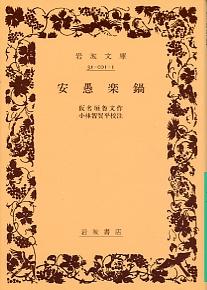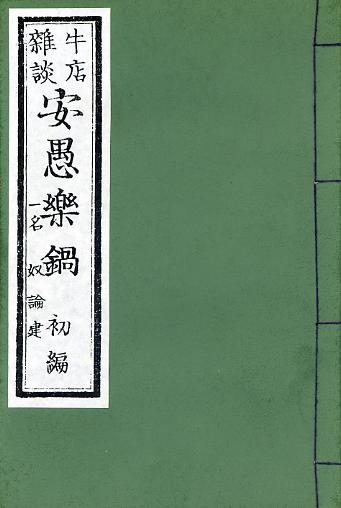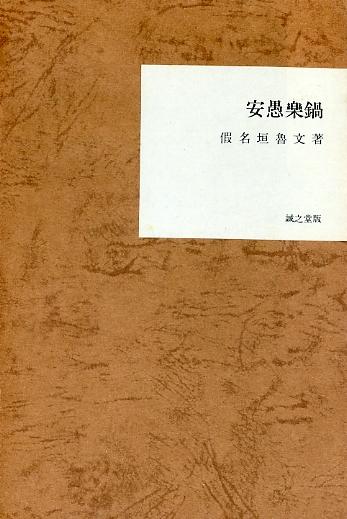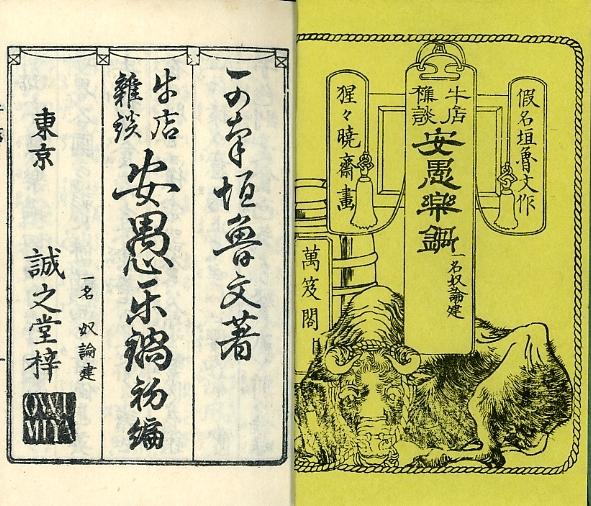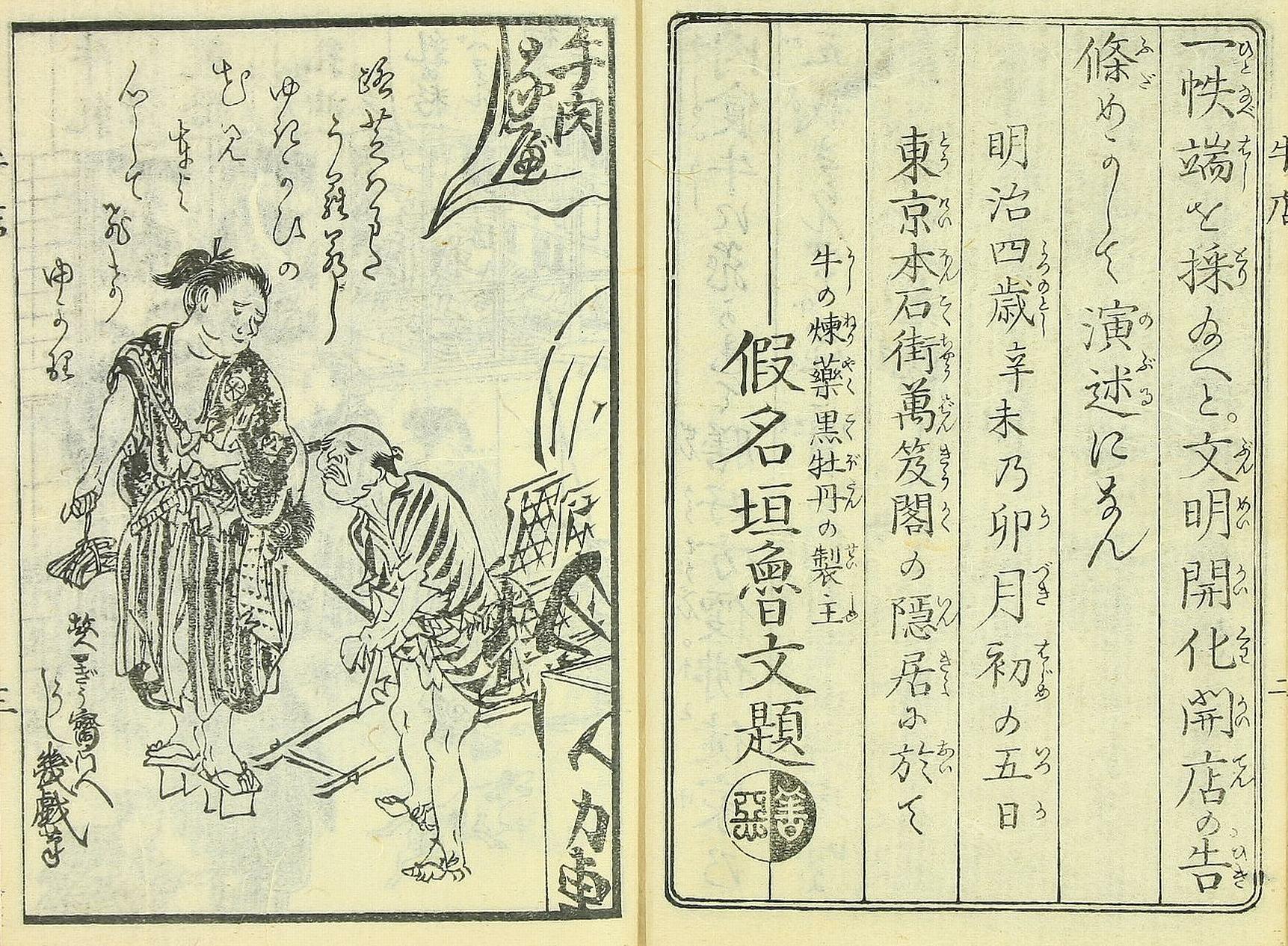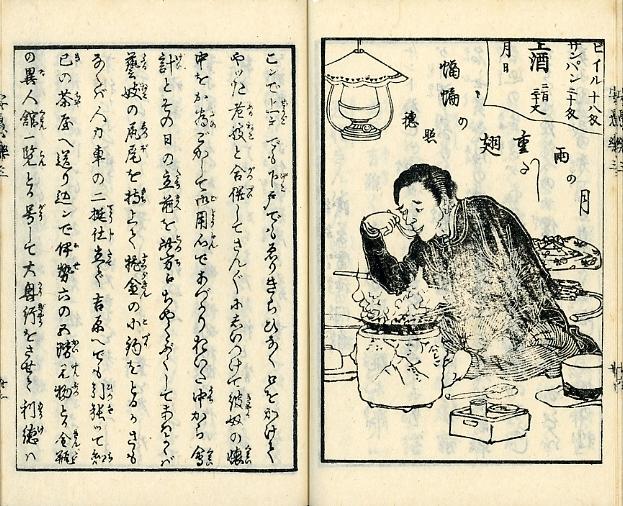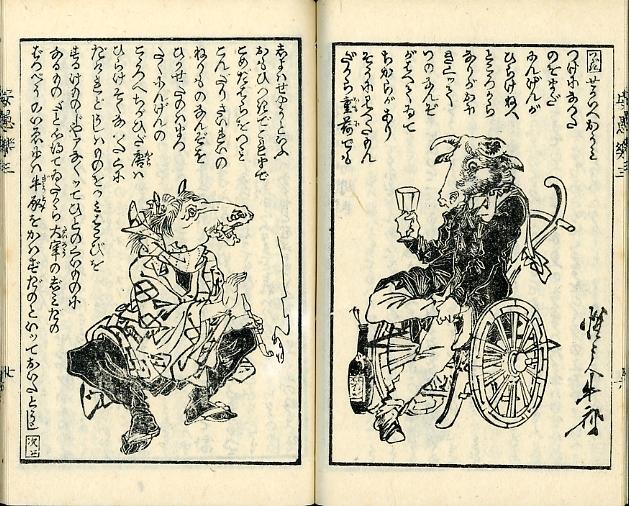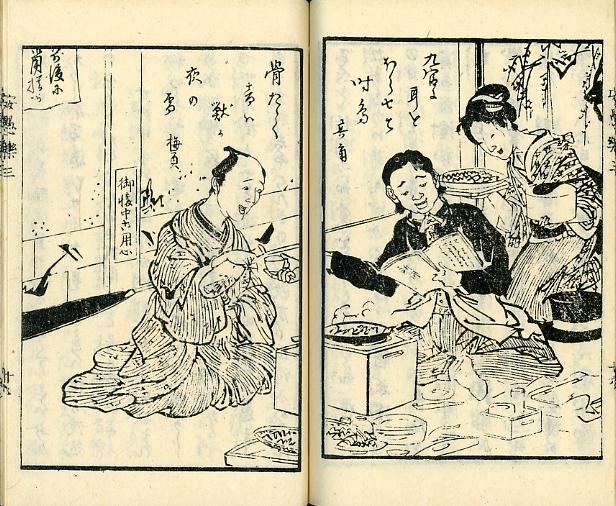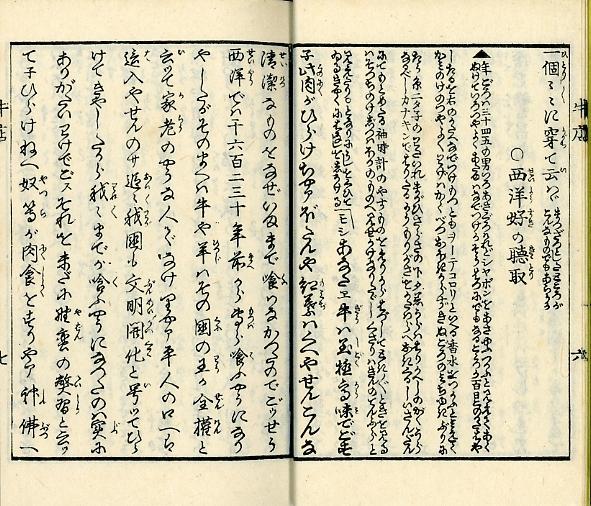Kanagaki Robun's Aguranabe
Beef, sake, news, and Westophiles in Early Meiji Japan
By William Wetherall
First posted 20 January 2008
Last updated 23 March 2010
Aguranabe Bunko | Facsimile | Particulars | Signatures | Beef eater | Cow and horse | Reading news | Westophiles
See Kanshiro hirome tebikae for a look at Kanagaki Robun in Takahashi Katsuhiko's Kanshiro series.
Kanagaki Robun's Aguranabe
Kanagaki Robun (1829-1894) was one of the most important writers of both fiction and reportage in the late Edo and early Meiji periods. He was closely associated with sketch artists like Yoshiiku and also worked with Yoshitoshi. See Kanagaki Robun in the Who's Who in the Almanac section for more about him and his writing.
Aguranabe
Kanagaki is best known for a collection of parodic stories called "Ushiya zōdan / Aguranabe" (���X�G�k �^ �����y��) or "Beef-shop small-talk: Cross-legged [at a beef] pot". The stories are humorous takes on people who flock to "beef shops" (���X ushiya, gy#363;ten) or "beef-pot shops" (���牮 gyūnabeya) to sit around pots of beef (���� gyūnabe, ushinabe), drink sake, smoke tobacco, and read the news or gossip.
"Aguranabe", as the story is usually called, was published as three volumes (��) in five fascicles (��). The first volume (one book) and second volume (two books) came out in 1871, and the third volume (two books) appeared in 1872. Here I will refer to the five books in three volumes as 1, 2a and 2b, and 3a and 3b.
The word "agura" is usally graphed �Ӎ� or �Ӎ� (both of which are read "koza" in Sino-Japanese) if not �ӏ� (koshō). It derives from Japanese "a" meaning "foot" or "leg" and "kura" meaning a mount or platform on which one sat, usually while folding the legs and crossing the ankles. In time the word designating the seat became the term for the manner of sitting. The term "kura", which also means "saddle", is a suffix in a number of words, including -- possibly -- "makura" or "pillow" which seats or rides the head (atama).
Why Robun graphed the word �����y (a-gu-ra) is a bit of a mystery. On the surface it is an example of the sort of visual wordplay that gesaku writers in particular loved. Here it might (according to some people) imply that sitting cross-legged at a pot of beef was "cheap, simple-minded, and pleasurable" way to put on airs of civilization and enlightenment.
The story pokes fun at the rush to abandon the native in favor of the exotic -- particularly men who sit cross-legged before a steaming beef pot while drinking conventional sake and reading "news" (shinbun) in a newfangled "newspaper" (shinbunshi) For details on this important reference to the growing popularity of newspapers the very year Tokyo's first daily papers appeared, see On "nishikie shinbun".
Editions
Aguranabe has been published in numerous editions, beginning with its original woodblock-printed booklets, followed by moveable-type editions, compact bunko editions, and now electronic text editions. In addition, there both printed facsimilies and electronic scans of early woodblock editions.
Here I have used the Iwanami bunko edition to facilitate reading a paper facsimile edition, while also consulting high resolution color scans of a similar edition available on-line through the Old and Rare Materials Collection database at Waseda University Library.
Iwanami bunko editionAguranabe is most accessible in the following fully annotated and illustrated bunko edition of Kobayashi Chikahira's recension of the Seishidō text.
|
Publishing particularsA decorative plate showing the title, and the names of the author or compliler, drawer, and publisher, is sometimes pasted inside the front cover. Only Volume 1 of the facsimile edition of Aguranabe shows such a plate, printed black-on-green. Note, also, that the publisher on the decorative plate, and the publisher on the opposing title page (1a), appear to be different. Three of the five books in the complete set in the Yanagida Izumi Bunko collection at Waseda University Library -- Volumes 2a, 3a, and 3b -- have decorative title plates inside the front cover. The plate in the facsimile edition resembles the plate in Volume 3b of the Waseda set in both its design and particulars. All books in the the facsimile set have green covers. The first four books of the complete Yanagida (Waseda) set have green covers, while only the last book (Volume 3b) has a brown cover. The covers of the both books (Volumes 2a and 2b) in the incomplete Yanagida set are brown or tan. |
| Title page on first leaf (1a) | Decorative plate inside front cover |
|
��_�D���� ���� / �y�� ���X�G�k ���� �ꖼ �z�_�� / ���� ���V���� OWU / MIYA |
��_�D���� ���� / �y�� ���X�G�k �ꖼ �z�_�� �́X���V�` ���t |
NotesBankūkaku, a Tokyo woodblock printer and bookseller, was also, at the time, publishing Kanagaki's comic saga Seiyō dōchū hizakurige (���m�����G�I��). This work, begun in 1870, ran to 15 volumes in 30 fascicles (booklets) when finished in 1876. The final volumes, 12-15, are attributed to Kanagaki's friend, the gesaku writer Fusō Kan (������ 1841-1894), signing as "Misugi Yosugi Fusō Kan" (�����q������). Apparently Book 2 of Volume 6 of "Hazakurige" published an excerpt from "Aguranabe" by way of promoting the forthcoming work, but the excerpt never appeared in the finished version (Kobayashi in Kanagaki 1997:6). doronken (�z�_��) is a transliteration of �h�����P�� from Dutch "dronken" meaning "drunk". This word, also written �h�����P�� (dorinken) and �g�����P�� (torinken), appears to have been part of the port lingo of the time (Kojien). The characters Kanagaki used to represent the word could be taken to mean "construction of debate by slaves/servants". Tokei reflects the furigana provided for ���� at the end of the preface (see below) and elsewhere. It would be several years before the name of the city was standardized as Tōkyō. black botan reflects �����O (kurobotan, kokubotan) -- a dark purple peony. Here the expression is cant for cow, steer, or water buffalo. |
|
The decorate plate inside the front cover of the facsimile edition attributes the drawings to Shōjō Kyōsai (�́X���V�`). While some descriptions of Aguranabe -- including Kobayashi's (Kanagaki 1997:8) -- state that Yoshiiku was the illustrator, several pictures bear one or another of Kawanabe Kyosai's signatures. However, Yoshiiku was clearly a principal illustrator.
Variations in decorative plates and title pages
The left column of the tripart title page of the facsimile edition shows first (right) the subtitle "Ichimyō Doronken" and the second (left) the city and publishing company "Tōkei Seishidō shi" and a seal reading "OWU / MIYA" (Ōmiya). The hand is clearly different from that of the columns for the author's name and the main title.
The left column of the title page on the Yanagida Izumi Bunko copy in Wasuda University Library, however, shows only the subtitle "Ichimyō Doronken" -- in larger script, laterally centered, justified at the bottom with the main title in the adjacent column -- and in the same hand.
Decorative title plates on Waseda set
While the facsimile edition has only one decorative title plate, the set of booklets in the Yanagida collection at Waseda has three different plates, as follows.
Volume 1 No decorative plate
No publisher's name on facing title pageVolume 2a Black-on-white decorative plate
���V�F��� Keisai Yoshiiku ga [Drawings by Yoshiiku]
���V������ Seishidō ban [Published by Seishidō]Volume 2b No decorative decorative plate
Volume 3a Black-on-whited ecorative plate
�́X���V�` Shōjō Kyōsai ga [Drawings by Shōjō Kyōsai]
���V���� Seishidō shi [Blocks (Printing) by Seishidō]
[Here �� is written �{���{�r rather than �{�h]Volume 3b Black-on-yellow decorative plate
�́X���V�` Shōjō Kyōsai ga [Drawings by Shōjō Kyōsai]
���t Bankyūkaku [(Published by) Bankyūkaku]
Preface and frontispiece signaturesAguranabe begins with a four-page preface which Kanagaki dates, signs, and seals like this (Volume 1: 2b).
BankyukokuKanagaki appears to be practically living at Bankyūkoku, the Tokyo woodblock printer and bookseller which was publishing another of his stories (see above). Zen-AkuThe seal reads, right to left, white �P (zen, "good") on black, black �� (aku, "evil") on white. Kanagaki was known for using a seal that read �P in white and �� in vermilion -- when using cinnabar ink. The preface is printed with a woodblock that would have been cut from a sheet of paper on which Kanagaki had brushed the text and affixed his seal -- with cinnabar ink. The red parts of the seal are thus printed as black. FrontispieceBoth copies of the first book of Volume 2 in Waseda's Yanagida Bunko credit Keisai Yoshiiku with the drawings, and indeed his hand is seen in a number of the illustrations in Aguranabe. The kuchie or "frontispiece" following Kanagaki's preface in Volume 1 (is clearly signed by Yoshiiku -- in a manner that exemplifies his well-known sense of humor (Volume 1: 3a). |
BeefeaterA young man who likes the west sits cross-legged at a beef pot simmering over coals in a hibachi. He holds a cut of sake in one hand while spooning beef broth with the other. A pipe and smoking box sit on the floor. The menu in the upper right reads as follows.
|
|||
Cow and horse |
Man reading news |
|
Catching the talk of a westophile A partial translation from Kanagaki Robun's Aguranabe (1871-1872) |
|||
Japanese textThe graphic transcription, including the furigana, reflects the text in the Kindai Bungaku Kan facsimile edition of the Seishidō fascicle edition (1968, Volume 1, 6a-10a). The punctuation, however, is based on the Iwanami Shoten bunko edition (5th printing, 1997, pages 28-29), which also informed some of the commentary. Furigana are shown in (small parentheses) following the graphs they appeared beside in the facscimile edition. The bold emphasis for purposes of commentary is mine (Wetherall). English translation and commentaryBoth the structural translation and the commentary are mine mine (Wetherall). |
|||
Beginning of "Seiyozuki no kikitori" text (Volume 1: 6a-7a)
|
|||
���m�D(����)�̒���(���T�Ƃ�)�N����͎O�\�l�܂̒j�A���날�����낯��ǁA�V���{����������ӂ��ӂƌ����āA�����ʂ��Ă����悭�A�����܂͂Ȃł����A�����͂ɂł��Ȃ�Ƃ��낪�A�S�����̂����͂₵������A�E�̂����ւȂł��A���Ƃ����[�e�R�����Ƃ��ւ�A���������ӂƂ݂��āA���݂̂��̂�悭�A�킰�͂����ׂ��ق����炸�B���ʂ���݂̂��䂫�Ԃ�ɁA��������^�q�̂킽����܂��ЁA���炳�̉��^������́A�͂肩�ւ��̂�������Ȃ�ׂ��B�J�i�L���ł͂肽��A�������肪�����A�����͂�ւ����A���邵������ɂĂ��Ƃ߂���A�����v�̂₷���̂��A���肩��͂Â��āA�Ƃ��ǂ��Ƃ�������͂����̂��A���͂ق��̂��̂ցA���������Ȃ�B���U��������́A����̂Ă�Ղ�ƌ�������B�ƂȂ�ɂ��������ЂĂ��A���₭�ɂ͂Ȃ�����������B �u���V ���Ȃ����A��(����)�͎��ɍ���(������������)�ł����q�B �������Ђ炯����A�A�ڂ����g�t(���݂�)�́A���ւ₹��B��������������̂��A�Ȃ����܂܂ŁA��͂Ȃ����̂ł��E�����B���m�ł́A��Z�S��O�\�N�O����A��(����)���ӂ₤�ɂȂ�₵�����A���̂܂��́A����r�͂��̚��̉����A�S�܂Ɖ]�c�āA�ƘV�̂₤�Ȑl�łȂ����A�A���l�̌��ւ́A����(�͂���)�₹��̃T�B�ǁX�䚠���A�����J�����j(��)�c�āA�Ђ炯�Ă��₵������A��X�܂ł��A��ӂ₤�ɂȂ��̂́A���ɂ��肪�����킯�ł��X�B����𖢂��ɁA���ł̕��K(�ւ�����)�Ɖ]�c�Ďq�A�Ђ炯�˂��z�����A���H�����A�A�~��(����Ԃ�)�֎肪������˂ւ́A�����q(����)����̂ƁA�킩��˂֖��(���)�����ӂ̂́A�����{��(�킫��)�ւ˂ւ���́A���Ƃł��X�B����Ȉ�(��т�)�ɁA���V�̒�(����)�����H�̐��ł��A椂��Ă֎q�B���V���m�ɂ�A�A����Ȃ��Ƃ͂��E����A[���̐l������܂�����A���E����A������܂����A���X�ȂǁA���ӂ�������B] �ޓy(����)�͂��ׂāA���ł����čs(�䂭)�����炾����A�E�E�E�v |
Catching [the talk] of a westophileA man some thirty four or five in years, his color [complexion] was light black, but he appears to use soap mornings and evenings, [as] the grime is gone and the luster of his color [complextion] is good . . . . To be continued. "Hello there. Beef is extremely delicious, no? When this meat spreads, we won't be able to eat peony or maple leaves. Why until now haven't we eaten anything so clean? In the west [western sea], [people] came to mainly eat [beef] from one-thousand six-hundred and twenty or thirty years ago, and before that, beef and mutton -- if one wasn't the king of the country, or someone like a house elder, involking complete authority -- never entered [crept toward and into] the mouths of ordinary people. Step by step [in] our country too, in the name of civilization and enlightenment, [beef] has come to spread, so even we have come to eat [it], a truly thankful situation. To be continued. |
||
Notes and commentaryspreads reflects �Ђ炯����A (hirakechaa < hirakete wa) -- opens out, unfolds, progresses, develops, blossoms -- said of roads, civilization, opportunity, hope, computer files, even flowers. This resonates not only with the flowerful metaphors for venison and wild boar, but also with the later phrasing -- "step by step . . . in the name of civilization and enlightement, [beef] has come to spread" (�ǁX . . . �����J�����j�c�āA�Ђ炯�Ă��₵�� bunmei kaika to itte, hirakete kiyashita). Note that "step by step [gradually] spreading" (�ǁX�J�� oioi hirake) was a common expression, found also in TNS-876. peony and maple leaves reflects �ڂ����g�t (���O��g�t botan ya momiji) == "boar meat (���� shishiniku) and deer meat (���� shikaniku). The term "beef pot" (���� gyū nabe) was inspired by expressions like "boar pot" (���O�� botan nabe, ���� inoshishi nabe) and "venison pot" (�g�t�� momiji nabe). Another oblique reference to boar -- to get around prohibitions and taboos about eating meat -- was "mountain whale" (�R�~ yamakurjira). Similarly, horse flesh for human consumption was (and still is) called "cherry blossoms" (�� sakura). Horse meat sashimi is just "sakura" and a "horse meat pot" is "sakura nabe" (����). During the Tokugawa period, farmers around Edo would shoot boar and deer as pests, and ship them to shops in Edo called "momonjiya" (������) among other names. People would cook such meat in iron pots, much like sukiyaki today, or on iron plates like teppanyaki. clean reflects ������ (seiketsu-na) -- as opposed to being dirty (�q��� kegareru) in the sense of being defiled, polluted, soiled, impure, unclean. house elder reflects �ƘV (kaō), the highest ranking (chief) retainers serving the lord of a domain. ordinary people reflects ���l (hirabito, heijin, heinin). Between 1869 and 1871, shortly before Robun wrote this, Tokugawa laws concerning status were revamped or abbrogated, so that formal distinctions between warriors, farmers, craftsmen, merchants, and outcastes were generally reduced to "samurai descendants" (�m�� shizoku), meaning disenfranchised, hence former, samurai -- "ordinary folk" (���� heimin), meaning ordinary or common people -- in addition to members of the imperial family and the titled nobility. To be continued. |
|||
